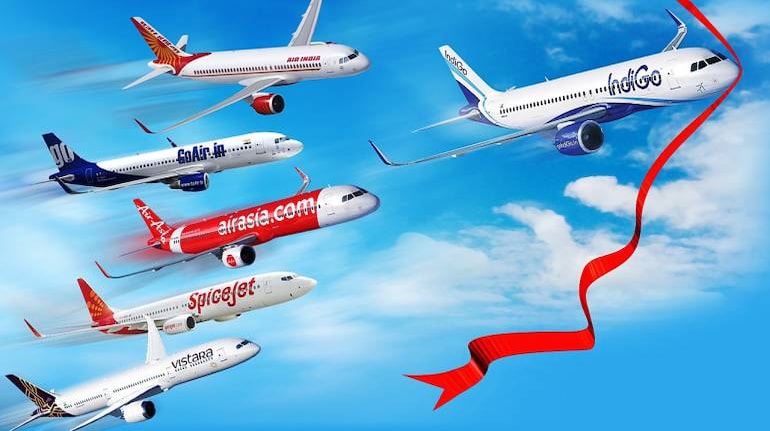



The Directorate General of Civil Aviation forecasts a boost for air traffic in India in the coming months as the upcoming festive season and the withdrawal of caps of fares from August-end are set to provide a much-needed boost to the pandemic-battered sector.
The aviation regulator also said there was no need for panic or anxiety with regard to recent snags reported by some domestic airlines and said that “safety is non-negotiable”.
The Central government, heeding a call by Indian carriers, ordered the withdrawal of limits imposed on airfares, a practice that started soon after the outbreak of the Covid-19 pandemic.
DGCA Director General Arun Kumar said the withdrawal of these caps will allow airlines to offer lower fares and attract more passengers.
“The fare band withdrawal is a major step to boost the industry,” Kumar told Moneycontrol in an interview. “High jet fuel costs as well as the pandemic slowed the growth of passenger traffic. However, steps like these will nudge passenger traffic growth, encourage airlines to offer competitive fares, and incentivise passengers. But all this is contingent on the premise that there are no new Covid waves.”
High air fares on the back of a surge in jet fuel costs have dampened demand during the traditionally weak travel season. Consequently, the daily passenger count hovers around an average of 335,000, a number that’s expected to touch 390,000-400,000 in the coming period.
Passenger traffic stood at 10.5 million in June, lower than 12 million recorded in May, 11 million in April, and 10.6 million in March. July passenger traffic numbers are expected next week.
Pandemic measure
India regulated airfares to protect both passengers and airlines from the aftermath of the pandemic. An unprecedented surge in pent-up demand and more recently, jet fuel prices, were cited as the main reasons for implementing the system.
The setting of upper and lower airfare limits was introduced in May 2020, after the first national lockdown. Notably, the Centre imposed limits on airfares based on flight duration and these curbs were applicable for a 15-day period.
In its revocation order, the ministry of civil aviation said: “After review of the current status of scheduled domestic operations vis-à-vis passenger demand for air travel… it has been decided to remove the fare bands notified from time to time regarding airfares with effect from August 31, 2022.”
Domestic carriers had started to clamour for removal of the fare caps. Airline executives argued that the system hindered the application of market-driven fares and pointed out their inability to pass on high jet fuel prices or offer sales.
Kumar pointed out that the pandemic had slowed the growth rate of passenger addition.
“If the pandemic hadn’t hit, the overall per day numbers would have been close to 4.5 lakh,” he said. “This means we are still behind the pre-Covid growth curve.”
The DGCA chief said all airlines are adhering to standard operating systems for safe operations. If a lapse comes to notice, enforcement action is taken, Kumar said.
“Safety is non-negotiable and all stakeholders are supposed to carry out their assigned roles,” he said.
Routine snags
Talking of some recent incidents involving Indian carriers, he said these were routine snags and should not cause “panic or anxiety.”
“All that is needed is a proper response as per the manuals available to the flight crew,” he added. “A ‘reject take off’ or an air turnback if the weather radar is dysfunctional or TCAS (traffic collision avoidance system) is not working or if the pilot experiences vibrations in the engine for some reason should not unsettle us. We should remember that these are routine events and do keep happening to all airlines across the world.”
Apart from physical inspections, the DGCA has kept an eye on the impact of financial strain on airlines’ operations. Under its financial assessment code, the DGCA routinely checks the availability of necessary spares and technical staffing.
“We are mostly concerned with the airlines’ ability to afford spares, technical manpower and to properly follow-up with safety checks,” Kumar said.
According to Kumar, the DGCA is expanding and aggressively hiring, even from the private sector.
“We plan to hire 100-150 professionals in the next few months.” he said.
Currently, the DGCA has a strength of 1,300 personnel.
Discover the latest Business News, Sensex, and Nifty updates. Obtain Personal Finance insights, tax queries, and expert opinions on Moneycontrol or download the Moneycontrol App to stay updated!
Find the best of Al News in one place, specially curated for you every weekend.
Stay on top of the latest tech trends and biggest startup news.